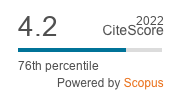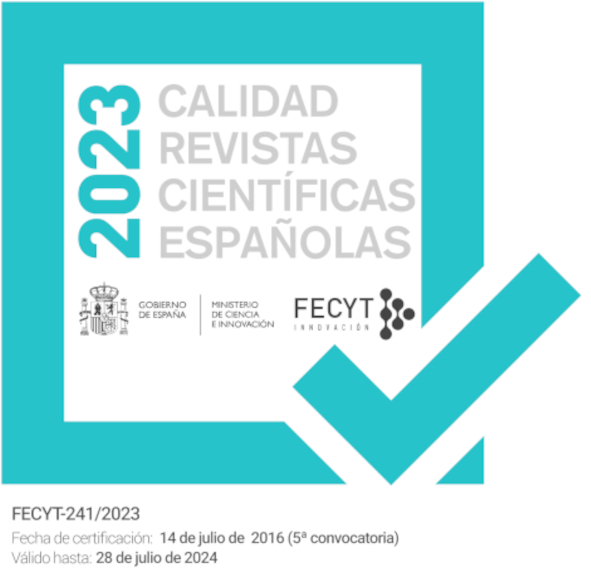Assessing hillslope-channel connectivity in an agricultural catchment using rare-earth oxide tracers and random forests models
DOI:
https://doi.org/10.18172/cig.3169Keywords:
Sediment Tracing, Random Forests, Mediterranean, hillslope-channel connectivityAbstract
Soil erosion from agricultural areas is a large problem, because of off-site effects like the rapid filling of reservoirs. To mitigate the problem of sediments from agricultural areas reaching the channel, reservoirs and other surface waters, it is important to understand hillslope-channel connectivity and catchment connectivity. To determine the functioning of hillslope-channel connectivity and the continuation of transport of these sediments in the channel, it is necessary to obtain data on sediment transport from the hillslopes to the channels. Simultaneously, the factors that influence sediment export out of the catchment need to be studied. For measuring hillslope-channel sediment connectivity, Rare-Earth Oxide (REO) tracers were applied to a hillslope in an agricultural catchment in Navarre, Spain, preceding the winter of 2014-2015. The results showed that during the winter no sediment transport from the hillslope to the channel was detected.
To test the implication of the REO results at the catchment scale, two contrasting conceptual models for sediment connectivity were assessed using a Random Forest (RF) machine learning method. The RF method was applied using a 15-year period of measured sediment output at the catchment scale. One model proposes that small events provide sediment for large events, while the other proposes that only large events cause sediment detachment and small events subsequently remove these sediments from near and in the channel. For sediment yield prediction of small events, variables related to large preceding events were the most important. The model for large events underperformed and, therefore, we could not draw any immediate conclusions whether small events influence the amount of sediment exported during large events. Both REO tracers and RF method showed that low intensity events do not contribute any sediments from the hillslopes to the channel in the Latxaga catchment. Sediment dynamics are dominated by sediment mobilisation during large (high intensity) events. Sediments are for a large part exported during those events, but the system shows a memory of the occurrence of these large events, suggesting that large amounts of sediments are deposited in and near the channel after these events. These sediments are gradually removed by small events. To better understand the delivery of sediments to the channel and how large and small events influence each other more field data on hillslope-channel connectivity and within-channel sediment dynamics is necessary.Downloads
References
Baartman, J.E.M., Jetten, V.G., Ritsema, C.J., Vente, J. 2012. Exploring effects of rainfall intensity and duration on soil erosion at the catchment scale using openLISEM: Prado catchment, SE Spain. Hydrological Processes 26, 1034-1049. DOI: http://doi.org/10.1002/hyp.8196.
Basher, L.., Ross, C. 2001. Role of wheel tracks in runoff generation and erosion under vegetable production on a clay loam soil at Pukekohe, New Zealand. Soil & Tillage Research 62, 117-130. DOI: http://doi.org/10.1016/S0167-1987(01)00220-3.
Ben Slimane, A., Raclot, D., Evrard, O., Sanaa, M., Lefevre, I., Le Bissonnais, Y. 2016. Relative Contribution of Rill/Interrill and Gully/Channel Erosion to Small Reservoir Siltation in Mediterranean Environments: Catchment Erosion Processes in Mediterranean Environments. Land Degradation & Development 27, 785-797. DOI: http://doi.org/10.1002/ldr.2387.
Bracken, L.J., Croke, J. 2007. The concept of hydrological connectivity and its contribution to understanding runoff-dominated geomorphic systems. Hydrological Processes 21, 1749-1763.
Bracken, L.J., Turnbull, L., Wainwright, J., Bogaart, P. 2015. Sediment connectivity: a framework for understanding sediment transfer at multiple scales: Earth Surface Processes and Landforms 40, 177-188. DOI: http://doi.org/10.1002/esp.3635.
Breiman, L. 2001. Random forests. Machine Learning 45, 5-32.
Brunsden, D. 1993. The persistence of landforms. Zeitschrift für Geomorphologie Supplementband 93, 13-28.
Cammeraat, L.H. 2002. A review of two strongly contrasting geomorphological systems within the context of scale. Earth Surface Processes and Landforms 27, 1201-1222. DOI: http://doi.org/10.1002/esp.421.
Cantón, Y., Domingo, F., Solé-Benet, A., Puigdefábregas, J., 2001. Hydrological and erosion response of a badlands system in semiarid SE Spain. Journal of Hydrology 252, 65-84. DOI: http://doi.org/10.1016/S0022-1694(01)00450-4.
Casalí, J., Gastesi, R., Álvarez-Mozos, J., De Santisteban, L.M., Del Valle de Lersundi, J., Giménez, R., Larrañaga, A., Goñi, M., Agirre, U., Campo, M.A., López, J.J., Donézar, M. 2008. Runoff, erosion and water quality of agricultural watersheds in central Navarre (Spain). Agricultural Water Management 95, 1111-1128. DOI: http://doi.org/10.1016/j.agwat.2008.06.013.
Casalí, J., Giménez, R., Díez, J., Álvarez-Mozos, J., Del Valle de Lersundi, J., Goñi, M., Campo, M.A., Chahor, Y., Gastesi, R., López, J. 2010. Sediment production and water quality of watersheds with contrasting land use in Navarre (Spain). Agricultural Water Management 97, 1683-1694. DOI: http://doi.org/10.1016/j.agwat.2010.05.024.
Cerdà, A., Flanagan, D.C., le Bissonnais, Y., Boardman, J. 2009. Soil erosion and agriculture. Soil & Tillage Research 106, 107-108. DOI: http://doi.org/10.1016/j.still.2009.10.006.
Chahor, Y., Casalí, J., Giménez, R., Bingner, R.L., Campo, M.A., Goñi, M. 2014. Evaluation of the AnnAGNPS model for predicting runoff and sediment yield in a small Mediterranean agricultural watershed in Navarre (Spain). Agricultural Water Management 134, 24-37. DOI: http://doi.org/10.1016/j.agwat.2013.11.014.
Collins, A.L., Davison, P.S. 2009. Mitigating sediment delivery to watercourses during the salmonid spawning season: Potential effects of delayed wheelings and cover crops in a chalk catchment, southern England. International Journal of River Basin Management 7, 209–220. DOI: http://doi.org/10.1080/15715124.2009.9635384.
Deasy, C., Quinton, J.N. 2010. Use of rare earth oxides as tracers to identify sediment source areas for agricultural hillslopes. Solid Earth 1, 111-118. DOI: http://doi.org/10.5194/se-1-111-2010.
Feller, W. 1968. An introduction to probability theory and its applications. Volume I, John Wiley & Sons London.
Francke, T., López-Tarazón, J.A., Schröder, B. 2008. Estimation of suspended sediment concentration and yield using linear models, random forests and quantile regression forests. Hydrological Processes 22, 4892-4904. DOI: http://doi.org/10.1002/hyp.7110.
García-Orenes, F., Cerdà, A., Mataix-Solera, J., Guerrero, C., Bodí, M.B., Arcenegui, V., Zornoza, R., Sempere, J.G. 2009. Effects of agricultural management on surface soil properties and soil–water losses in eastern Spain. Soil & Tillage Research 106, 117-123. DOI: http://doi.org/10.1016/j.still.2009.06.002.
Garcı́a-Ruiz, J.M., Arnáez, J., Beguerı́a, S., Seeger, M., Martı́-Bono, C., Regüés, D., Lana-Renault, N., White, S. 2005. Runoff generation in an intensively disturbed, abandoned farmland catchment, Central Spanish Pyrenees. Catena 59, 79-92. DOI: http://doi.org/10.1016/j.catena.2004.05.006.
Giménez, R., Casalí, J., Grande, I., Díez, J., Campo, M.A., Álvarez-Mozos, J., Goñi, M. 2012. Factors controlling sediment export in a small agricultural watershed in Navarre (Spain). Agricultural Water Management 110, 1-8. DOI: http://doi.org/10.1016/j.agwat.2012.03.007.
Gobierno de Navarra 2001. Estudio Agroclimático de Navarra (CD). Gobierno de Navarra, Departamento de Agricultura, Ganadería y alimentación, Servicio de Estructuras Agrarias, Pamplona.
Gómez-Plaza, A., Martı́nez-Mena, M., Albaladejo, J., Castillo, V. 2001. Factors regulating spatial distribution of soil water content in small semiarid catchments. Journal of Hydrology 253, 211-226. DOI: http://doi.org/10.1016/S0022-1694(01)00483-8.
Guzmán, G., Quinton, J.N., Nearing, M.A., Mabit, L., Gómez, J.A. 2013. Sediment tracers in water erosion studies: current approaches and challenges. Journal of Soils and Sediments 13, 816-833. DOI: http://doi.org/10.1007/s11368-013-0659-5.
Harvey, A.M. 2001. Coupling between hillslopes and channels in upland fluvial systems: implications for landscape sensitivity, illustrated from the Howgill Fells, northwest England. Catena 42, 225-250. DOI: http://doi.org/10.1016/S0341-8162(00)00139-9.
Heathwaite, A.L., Quinn, P.F., Hewett, C.J.M. 2005. Modelling and managing critical source areas of diffuse pollution from agricultural land using flow connectivity simulation. Journal of Hydrology 304, 446-461. DOI: http://doi.org/10.1016/j.jhydrol.2004.07.043.
Hengl, T., Heuvelink, G.B.M., Kempen, B., Leenaars, J.G.B., Walsh, M.G., Shepherd, K.D., Sila, A., MacMillan, R.A., Mendes de Jesus, J., Tamene, L., Tondoh, J.E. 2015. Mapping Soil Properties of Africa at 250 m Resolution: Random Forests Significantly Improve Current Predictions. PLOS ONE 10, e0125814. DOI: http://doi.org/10.1371/journal.pone.0125814.
Kimoto, A., Nearing, M.A., Shipitalo, M.J., Polyakov, V.O. 2006. Multi-year tracking of sediment sources in a small agricultural watershed using rare earth elements. Earth Surface Processes and Landforms 31, 1763-1774. DOI: http://doi.org/10.1002/esp.1355.
Kirkby, M., Bracken, L., Reaney, S. 2002. The influence of land use, soils and topography on the delivery of hillslope runoff to channels in SE Spain. Earth Surface Processes and Landforms 27, 1459-1473.
Masselink, R.J.H., Keesstra, S.D., Temme, A.J.A.M., Seeger, M., Giménez, R., Casalí, J. 2016. Modelling Discharge and Sediment Yield at Catchment Scale Using Connectivity Components. Land Degradation and Development 27, 933-945. DOI: http://doi.org/10.1002/ldr.2512.
Masselink, R.J.H., Heckmann, T., Temme, A.J.A.M., Anders, N.S., Gooren, H.P.A., Keesstra, S.D. 2017. A network theory approach for a better understanding of overland flow connectivity. Hydrological Processes 31, 207-220. DOI: http://doi.org/10.1002/hyp.10993.
Mekonnen, M., Keesstra, S.D., Baartman, J.E.M., Stroosnijder, L., Maroulis, J. 2016. Reducing Sediment Connectivity Through man-Made and Natural Sediment Sinks in the Minizr Catchment, Northwest Ethiopia: Sediment Trapping Approach Lack Integration. Land Degradation & Development 28 (2), 708-717. DOI: http://doi.org/10.1002/ldr.2629.
Michaelides, K., Wainwright, J. 2002. Modelling the effects of hillslope-channel coupling on catchment hydrological response. Earth Surface Processes and Landforms 27, 1441–1457. DOI: http://doi.org/10.1002/esp.440.
Poesen, J.W.A., Hooke, J.M. 1997. Erosion, flooding and channel management in Mediterranean environments of southern Europe. Progress in Physical Geography 21, 157-199. DOI: http://doi.org/10.1177/030913339702100201.
Polyakov, V.O., Nearing, M.A., Shipitalo, M.J. 2004. Tracking sediment redistribution in a small watershed: implications for agro-landscape evolution. Earth Surface Processes and Landforms 29, 1275-1291. DOI: http://doi.org/10.1002/esp.1094.
Thompson, C.J., Fryirs, K., Croke, J. 2016. The Disconnected Sediment Conveyor Belt: Patterns of Longitudinal and Lateral Erosion and Deposition During a Catastrophic Flood in the Lockyer Valley, South East Queensland, Australia: The Disconnected Sediment Conveyor Belt. River Research and Applications 32, 540-551. DOI: http://doi.org/10.1002/rra.2897.
Zabaleta, A., Martínez, M., Uriarte, J.A., Antigüedad, I. 2007. Factors controlling suspended sediment yield during runoff events in small headwater catchments of the Basque Country. Catena 71, 179-190. DOI: http://doi.org/10.1016/j.catena.2006.06.007.
Zhang, X.C., Friedrich, J.M., Nearing, M.A., Norton, L.D. 2001. Potential use of Rare Earth Oxides as Tracers for Soil Erosion and Aggregation Studies. Soil Science Society of America Journal 65, 1508. DOI: http://doi.org/10.2136/sssaj2001.6551508x.
Downloads
Published
How to Cite
Issue
Section
License
The authors retain copyright of articles and authorize Cuadernos de Investigación Geográfica / Geographical Research Letters the first publication. They are free to share and redistribute the article without obtaining permission from the publisher as long as they give appropriate credit to the editor and the journal.
Self-archiving is allowed too. In fact, it is recommendable to deposit a PDF version of the paper in academic and/or institutional repositories.
It is recommended to include the DOI number.
This journal is licensed under a Creative Commons Attribution 4.0 International License











